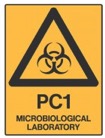Submitted by on 05 February 2016
Answer reviewed 24 January 2023
Biological Hazards
Biological hazards or biohazards are organisms or products that are harmful to human health and other living things. According to Safework Australia:
‘Biological hazards are organic substances that pose a threat to the health of humans and other living organisms. Biological hazards include pathogenic micro-organisms, viruses, toxins (from biological sources), spores, fungi and bio-active substances. Biological hazards can also be considered to include biological vectors or transmitters of disease’1
‘Exposure to biological hazards is therefore widespread and the risk of exposure is not always obvious’.1
Signage for Laboratories Using Microorganisms
Signs are used to inform personnel and visitors of potential hazards in the workplace.
The international biological hazard symbol is recognised worldwide as an indication of the presence of a biohazard. It is also used to identify rooms, equipment, containers etc., that either contain, or are contaminated with, a biological hazard.
The recommendation from the World Health Organisation (WHO) is that the international biohazard warning symbol be displayed prominently on doors to all laboratories and work areas where microorganisms of Risk Group 2 or higher are handled and/or stored.
Australian Requirements
The AS/NZS 2243.3:2022 Safety in Laboratories, Part 3: Microbiological safety and containment states:
“5.2 REQUIREMENTS FOR LABORATORY PC1 FACILITIES
5.2.1 General
A sign conforming to Appendix B showing the level of containment, together with hazard symbols as appropriate and any access restrictions, shall be prominently displayed at all entrances.”2
The biological hazard symbol according to Appendix B and as specified in AS 1319 is a black symbol on a yellow background. General microbiology laboratories should also have the laboratory containment level indicated on the sign in black letters as below.

School Science Laboratories
Generally, school science laboratories are classified as Physical Containment level 1 (PC1), if they conform to the requirements specified in Section 5 of AS/NZS 2243.3:2022. Safety in Laboratories, Part 3: Microbiological safety and containment. If school science laboratories conform to these requirements, they are only suitable for work with Risk Group 1 (RG1) microorganisms which present low individual and community risk and are unlikely to cause human or animal disease and where adequate protection for laboratory or facility personnel can be provided by standard laboratory practice.
This level of facility with its practices and equipment is usually suitable for secondary school teaching laboratories and undergraduate teaching laboratories. Higher levels of Physical Containment are required for handling microorganisms of Risk Groups 2–4.
Science ASSIST recommendations
Since microbiological activities are not conducted in every laboratory all year round, Science ASSIST recommends that a sign only be displayed at the entrance to the laboratory and/or preparation rooms whenever microbiological agents are being handled. The sign should be removed when biohazards are no longer present. This sign should include the biohazard symbol and laboratory containment level. Any access restrictions, plus contact information for responsible persons, should also be included.
A biohazard symbol should also be displayed on equipment such as incubators, fridges, freezers or containers when microorganisms are being stored. Again, this can be removed when the biohazard material has been removed.
There is no requirement to provide biohazard signage for food handling areas in the school environment.
Additional Information
As recommended by the World Health Organisation (WHO), Australian Standards have classified infectious microorganisms into four groups according to the degree of risk to humans, animals, plants and the environment. This classification system takes into account:
- the pathogenicity of the agent;
- the mode of transmission and the host range of the agent;
- the availability of effective preventative measures; and
- the availability of effective treatment.
Physical containment is the term used to describe facilities and procedures designed to reduce or prevent the release of viable organisms into the outside environment. In Australia, laboratories are classified into four levels of Physical Containment (PC 1–4). The level of containment must be of at least the level appropriate for the risk group of the microorganisms being used in the laboratory. That is, PC1 for RG1; PC2 for RG2 etc.
References
1 Safe Work Australia. (2011, March). ‘National Hazard Exposure Worker Surveillance: Exposure to Biological Hazards and the Provision of Controls against Biological Hazards in Australian Workplaces’, Safe Work Australia website https://www.safeworkaustralia.gov.au/resources-and-publications/reports/national-hazard-exposure-worker-surveillance-exposure-biological-hazards-and-provision-controls-against-biological-hazards-australian-workplaces. CC BY 4.0 licence © Commonwealth of Australia.
2 Standards Australia. (2022). AS/NZS 2243:3 2022, Safety in Laboratories, Part 3:Microbiological safety and containment This excerpt has been reproduced by ASTA with the permission of Standards Australia Limited under licence CLF1222asta. Copyright in AS/NZS 2243:3 2022, Safety in Laboratories, Microbiological safety and containment vests in Standards Australia [and Standards New Zealand]. Users must not copy or reuse this work without the permission of Standards Australia or the copyright owner.
Centers for Disease Control and Prevention, (2020, June). ‘Biosafety in microbiological and biomedical laboratories (BMBL) 6th Edition’, Centers for Disease Control and Prevention website, https://www.cdc.gov/biosafety/publications/bmbl5/ (accessed January 2023)
World Health Organization, (2020 December 21). ‘Laboratory biosafety manual’, 4th edition. World Health Organization website, https://www.who.int/publications/i/item/9789240011311 (accessed January 2023)

